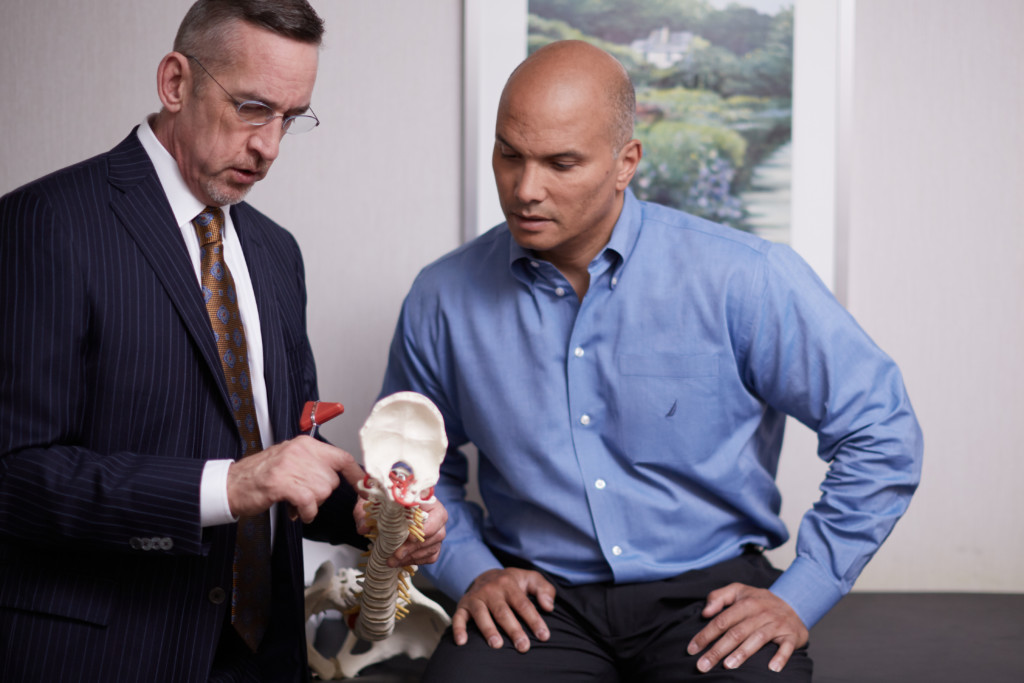Patient Centered Approach

The most important thing in treating any disorder of the spine or musculoskeletal system is to have an accurate diagnosis. Once you’ve given the patient a thorough examination and taken a very clear history, then you arrive at an accurate diagnosis. And from this accurate diagnosis, treatment of the spinal disorder or musculoskeletal condition can progress. A major part of the treatment process is the treatment philosophy, and that’s the ability to identify specifically what is the need of the individual, of the patient, and the best course of treatment.
Each condition has its own needs. For example, an elderly person may have a vertebral compression fracture and severe pain. We treat that fracture in a timely fashion, be it with a brace or with cement placed in the vertebrae, but in addition, working as a team, we have the right therapists to teach balance training and we have the right therapists to treat and strengthen the spine, as well as a nurse in the bone health program that will go ahead and work to manage and lessen the effects of osteoporosis that the patient is presented with.
Once you have an accurate diagnosis, you are able to have a clear, open and honest relationship with the patient and the family. Developing that connection early on is one of the things that we think is most important. Sometimes you have to share difficult information that isn’t always well received, but we believe a clear and honest explanation helps us, and the patient, plan for proceeding forward with or without surgery as an option.
Our relationship with the patient and their family helps with implementing the treatment model, and then, working as a team, restoring the patient to their best level of function. We always try to overshoot. We may use a therapist to teach the patient to use good nutrition after surgery to get the patient better than they were before they hurt themselves. That’s always the goal, to get the patient better than they were before they were hurt. We sometimes kid with the patients and their families that I’ve got them training for the Senior Olympics when they’re a senior patient.
It’s different when you have a patient with life altering conditions, such as cancer of the spine or infection of the spine, or individuals with multiple underlying conditions such as diabetes or rheumatoid arthritis, or those different factors that weaken their immune system. Again, we’re trying to strengthen the immune system before and after surgery to give them the best outcome for their treatment. The better shape we can get a patient in before the surgery, the better they can adjust to their outcomes.
We have an excellent care team. We have a team of non-operative physicians that are resources and provide many aspects of care including the non-operative management coordination of physical therapy, infection therapy, diagnostic techniques such as EMG nerve conduction studies, and diagnostic injections to identify which nerve is the one being irritated or compressed so we can direct treatment to that area. Then we have our surgeons. We have five orthopedic spine surgeons, so there’s always someone on-call that’s a fellowship trained surgeon and can deal with just about any aspect of acute emergency spine surgery.
In addition to our physician team, we have our mid-level providers, our physician’s assistants, our nurse practitioners, and our physical therapists. These individuals are providing direct event care of our patients. Our bone health nurse team is outstanding for managing osteoporosis with the latest techniques. And our therapists compliment them in working with balance training to prevent the elderly, whose balance sometimes is off, from falling and breaking another hip or another vertebrae.
Behind the mid-level providers is our nursing team. Our nursing team is there to answer questions and guide the patients, and get them in to see the physician on a timely manner. The nurses are our backup team and are very, very important.
And we help the patients help themselves. From a diet and nutrition standpoint, we typically use the Weight Watchers Program. It’s tried and true, and we have had many, many patients go through that program with good success. There are so many different dietary programs out there that we will direct people to, but we’re not prescribing at this time a specific diet plan for patients. Each patient has their own needs and we try and adapt to that.
So while we start with a doctor/patient relationship, we try and involve a whole circle of caring – the patient’s family, our surgical and non-surgical, and all of our collective knowledge to deliver the best opportunity for a patient’s well being.


